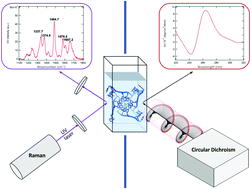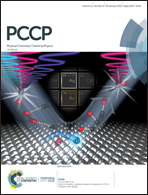Crowding and conformation interplay on human DNA G-quadruplex by ultraviolet resonant Raman scattering†
Abstract
The G-quadruplex-forming telomeric sequence (TTAGGG)4TT was investigated by polarized Ultraviolet Resonance Raman Scattering (UVRR) at 266 nm. The presence of 40% poly(ethylene glycol) and the so-called “self-crowding” condition were used to induce the hybrid-to-parallel topology transition. Analysis of frequency shifts with temperature showed the role of several functional groups in the topological transitions and provides structural dynamical information. Circular dichroism under similar conditions was used as a reference. UVRR shed light on the effect of intramolecular interactions and of local and environmental dynamics in promoting different G-quadruplex topologies, induced by solution conditions or by temperature changes. Overall, these findings showed the enormous potential of this spectroscopy for G-quadruplex conformational studies.



 Please wait while we load your content...
Please wait while we load your content...